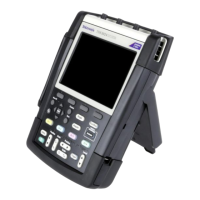Operating Basics
Connect Probe
s and Leads
You can connect voltage probes and test leads to any or all of the BNC connectors.
When using voltage probes, match the color of the probe with the color at the base
of the BNC con
nector to make it easy to see which channel you are using at a
glance. Following are some examples of how to connect probes and leads.
Beware of High Voltages
WARNING. To prevent electrical shock, do not exceed the measurement or floating
voltage ratings for the instrument input BNC connector, probe tip, or probe
reference lead.
Understand the voltage ratings for the probes you are using and do not exceed
those ratings. The following voltage ratings are important to know and understand:
The maximum measurement voltage from the probe tip and BNC signal to the
probe reference lead
The maximum floating voltage from the probe reference lead to earth ground
The maximum measurement voltage from the probe tip and BNC shell to
earth ground
These voltage ratings depend on the probe and your application. Refer to the
Specifications section in this manual for more information. (See page 95, Probe
Specifications.)
See the instruction sheet that shipped with your probes for more probe safety
information.
WA
RNING. To avoid electric s hock, do not use probes that require a ground
connection, such as the Tektronix P5200 High Voltage Differential Probe, with
the THS3000 Series Oscilloscopes. The P5200 High Voltage Differential Probe
requires an instrument with grounded inputs and the TH3000 Series Oscilloscopes
have floating inputs (isolated inputs).
20 THS3000 Series Oscilloscopes User Manual

